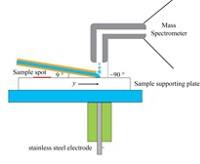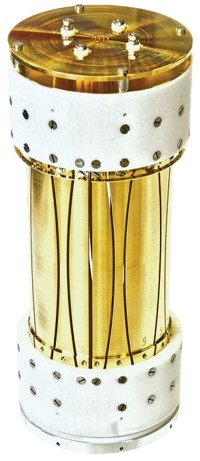Advertisement
Grab your lab coat. Let's get started
Welcome!
Welcome!
Create an account below to get 6 C&EN articles per month, receive newsletters and more - all free.
It seems this is your first time logging in online. Please enter the following information to continue.
As an ACS member you automatically get access to this site. All we need is few more details to create your reading experience.
Not you? Sign in with a different account.
Not you? Sign in with a different account.
ERROR 1
ERROR 1
ERROR 2
ERROR 2
ERROR 2
ERROR 2
ERROR 2
Password and Confirm password must match.
If you have an ACS member number, please enter it here so we can link this account to your membership. (optional)
ERROR 2
ACS values your privacy. By submitting your information, you are gaining access to C&EN and subscribing to our weekly newsletter. We use the information you provide to make your reading experience better, and we will never sell your data to third party members.
Analytical Chemistry
Speeding Up Mass Spec Imaging
Detector borrowed from high-energy physics makes it easy to create detailed images of tiny samples
by Celia Henry Arnaud
December 19, 2011
| A version of this story appeared in
Volume 89, Issue 51

A picture says more than words alone. That maxim is just as true for chemical images as it is for paintings or other illustrations. Mass spectrometric (MS) imaging reveals not only the chemical makeup of a sample but also the spatial distribution of species.

Conventional MS imaging draws chemical pictures dot-by-dot, much like a pointillist painting. In matrix-assisted laser desorption/ionization (MALDI) MS imaging, the most common type of MS imaging, a laser beam is moved laboriously from point to point, so that at each point the MS instrument can collect spectral information about species on the sample surface. If spectral acquisition takes a second per spot, then a 100 × 100 array takes nearly three hours to complete.
Mass spectrometrists trying to speed up this process have found one potential tool in the kit of high-energy physicists. A new detector, called the Timepix, allows researchers to acquire both the location and mass of ions in a 200-μm-diameter area on the surface.
The Timepix is particularly useful for MS imaging of very small samples where detailed information is needed, says Ron M. A. Heeren, a group leader at the Foundation for Fundamental Research on Matter (FOM) Institute for Atomic & Molecular Physics, in Amsterdam. Heeren and the father-and-son team of Andreas Bamberger, a high-energy physicist at the University of Freiburg, Germany, and Casimir Bamberger, a researcher at Scripps Research Institute, are independently pioneering the application of this detector to MS imaging.
In a prime example of the new detector’s power, Heeren’s group has collected images that reveal tiny features on fruit fly larvae. Heeren is using the Timepix and MS imaging to peer at a part of the fruit fly larva called the imaginal disc, which develops into the adult fly’s wing.
“In the development of Drosophila wings, there are particular signaling molecules that we would like to localize on the surface of these discs,” Heeren says. With conventional MS imaging, “we would use a long time to image those and not get the spatial detail we’re interested in. With this approach, we can do the entire wing disc rapidly with 500-nm pixels.” They acquire an entire image in about 30 minutes, 10 times as fast as using standard detectors.
Beyond speed, images obtained by this approach have another advantage over conventional MS scanning images—resolution.
The best spatial resolution a user can typically hope for with conventional MS imaging is about 100 μm. To show they can do better with the Timepix, the Bambergers and their colleague Uwe Renz collected digital MS images from a simple homebuilt time-of-flight mass spectrometer coupled with the detector (J. Am. Soc. Mass Spectrom., DOI: 10.1007/s13361-011-0120-1). They achieved spatial resolution of about 85 μm over a sample area of about 2 cm2, approximately the area covered by a standard histology tissue section.
Heeren and coworkers have pushed spatial resolution to 3.4 μm with the help of commercial mass spectrometers with high-quality ion optics and magnification properties that give better spatial resolution and wider mass range (Anal. Chem., DOI: 10.1021/ac2017629).
It may be possible to push spatial resolution into the nanometer range, Heeren says. But getting down to single nanometers won’t be easy and may not even be possible. “How many intact biomolecules will you actually desorb and ionize on a square nanometer? There aren’t going to be many,” he says.
The Timepix was developed at CERN, the European Organization for Nuclear Research, by the Medipix collaboration with support from the EUDET collaboration, both of which are projects to develop detectors for high-energy physics. Many organizations participated in the development, including the University of Freiburg and FOM. Physicists sought to develop a detector that would let them track the position of high-energy particles.
That detector consists of more than 65,000 individually programmable pixels. In one mode, a pixel counts the number of “clock cycles” between the laser pulse and the ion’s arrival at the detector. Because all ions are accelerated to the same kinetic energy, that flight time can be used to calculate the ion’s mass. In another mode, pixels can measure signal intensity by determining the length of time the charge is detectable. Pixels in these two modes can be arranged in different configurations on the Timepix.
Rather than measure ions directly, Heeren and the Bambergers both place a multichannel plate in front of the Timepix. When ions strike it, the multichannel plate generates an electron shower that the Timepix detects. Because of the signal amplification possible with the multichannel plate, the setup is more sensitive than the chip alone and can detect a wider concentration range of ions.
The Timepix captures a distinct ion mass every 10 to 20 nanoseconds, which corresponds to one clock cycle. However, because at most 10,000 clock cycles can be stored, only a limited mass range can be collected per laser shot. More masses can be collected by waiting before triggering the detector’s clock and then stitching the mass spectrum together. The clock speed determines the difference between distinct ion masses and thus the achievable mass resolution.
The clock speed—about 100 MHz—is still slow and thus the mass resolution is low. “If you compare that to the clocks used in standard mass spectrometers, it’s at least 10-fold too slow,” Casimir Bamberger says. He hopes the next generation of the chip will be at least 10 times as fast.
Even with those limitations, Heeren has been pleasantly surprised by the mass range that he can achieve with the Timepix. He was recently able to acquire an MS image of a large, 78-kilodalton, complex containing nine ubiquitin proteins. His team was able to acquire these mass spectra at an acceleration energy of only 3 kiloelectron volts (keV). Most commercial MALDI mass spectrometers require acceleration energies of 25 keV to achieve similar mass spectra. Heeren and his team are already planning to use higher acceleration energies to improve sensitivity for high-mass ions. “We expect that we’ll be able to extend it to even higher masses,” he says.
Heeren’s group has received a $1.3 million grant from the Dutch Technology Foundation to further develop the Timepix for MS imaging and for color X-ray imaging. As part of that work, Heeren plans to build more of these detectors and take them on the road to scientists who are interested in using them.




Join the conversation
Contact the reporter
Submit a Letter to the Editor for publication
Engage with us on Twitter